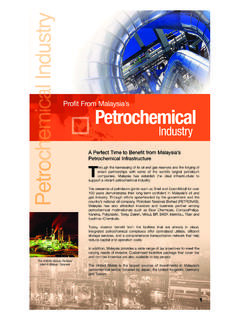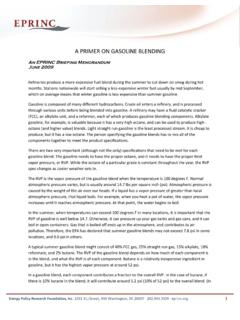Transcription of MTBE Frequently Asked Questions What is MTBE
1 mtbe Frequently Asked Questions what is mtbe ? mtbe (methyl tertiary butyl ether) is a chemical compound that is manufactured by the chemical reaction of methanol and isobutylene. mtbe is an "oxygenate", a component that contains oxygen. Oxygenates are used widely as a component of unleaded gasoline. mtbe is the most commonly used fuel oxygenate. It can be blended with petrol in any proportion up to 15%. Thanks to its adequate properties, mtbe is used as an "octane enhancer" to achieve the required octane level of gasoline. mtbe is a good alternative to other typical gasoline components. Why use mtbe ? mtbe has many properties that make it a good gasoline component for technical and environmental reasons: mtbe can be used as fuel that can supplement the supply of gasoline components.
2 Its high octane rating makes it an ideal substitute for other octane components, lead. It is an oxygenate, which can be used in the formulation of cleaner-burning gasoline. Lead has traditionally been added to gasoline due to its high octane rating, which prevents engine "knock". Lead is, however, a toxic compound, and leaded gasoline has been phased out in most areas of the world, including Europe. mtbe , which has a very high octane number but is not toxic, is ideally suited to produce high octane, unleaded gasoline. Adding oxygen to gasoline allows more complete combustion of the fuel, and this reduces exhaust emissions of CO (carbon monoxide). Furthermore, when used as part of the gasoline formulation, mtbe leads to a reduction in emissions of exhaust pollutants such as VOCs (volatile organic compounds), NOx (nitrogen oxides) and PM (particulates).
3 Reducing these pollutants improves air quality. By reducing the Ozone Forming Potential (OFP) of volatile organic compounds, mtbe . performs significantly better than other octane blending components. It generates about half of the ozone when compared to iso/alkylates and one-tenth that of aromatics. For all these reasons mtbe has been widely used all over the world for the last 20 years. Is mtbe used in Europe ? mtbe was invented in Europe, and has been widely used for over 20 years as a safe and clean octane enhancer, substituting lead. Because of its properties, mtbe is a good alternative to other typical gasoline components, leading to a reduction in the emissions of regulated as well as unregulated pollutants. In the 1990's some European countries - Finland - found these properties beneficial for the environment and decided to add up to 9-13 % of mtbe in gasoline.
4 CO emissions were reduced by 10-20% and hydrocarbons by 5-10%. As air quality became a real issue in Europe, the EU adopted a directive setting new specifications for gasoline (EC Directive 98/70/EC). Oxygenated compounds such as mtbe . will help the refining industry reach these new, stringent standards, so that Europe can enjoy better air quality. Is mtbe used in the USA ? In the USA, mtbe is used as an octane-enhancer and as the oxygenate of choice of the refining industry, following the implementation of the federal Clean Air Act and other state regulations. In 1990 the United States adopted the Clean Air Act Amendments (CAAA). These require the use of oxygen in gasoline in areas with unhealthy levels of air pollution. The CAA does not specifically require mtbe , just oxygen.
5 Although refiners may choose to use other oxygen- containing components, such as ethanol, mtbe is the most widely used oxygenate. The Clean Air Act sets out two types of gasoline specifications: Winter Oxyfuel Programme: Implemented since 1992, this requires the se of oxygenated fuel (gasoline containing percent oxygen by weight) during the cold months in cities that have elevated levels of carbon monoxide. Ethanol is primarily used as an oxygenate for this type of gasoline, as the cold weather compensates for the usual drawback presented by its high volatility. Year-round Reformulated Gasoline Programme: Since 1995, the CAA requires reformulated gasoline (RFG) year-round in cities with the worst ground-level ozone (smog). RFG is gasoline with very tight environmental specifications, which must among other ingredients contain a minimum of 2 percent oxygen by weight, and which is specially blended to have fewer polluting compounds than conventional gasoline.
6 Today, about 30 percent of US. gasoline is reformulated, of which about 87 percent contains mtbe . Refiners have chosen mtbe as the main oxygenate in RFG in cities outside of the Midwest primarily for economic reasons and because of its blending characteristics. Unlike ethanol, mtbe can be shipped through existing pipelines, and its volatility is lower, making it easier to meet the emission standards. Further to the federal Clean Air Act, and to address its unique air pollution problems, California has adopted similar, but more stringent requirements for its gasoline (California RFG). In view of widely-publicised, although limited, occurrences of groundwater contamination, California has decided to phase out mtbe from gasoline from 2004.
7 Implementation of this proposed legislation is uncertain and in fact California still relies on mtbe as its source of oxygen in gasoline, given the economic and environmental advantages that it brings. Are there any alternatives to mtbe ? Potential alternatives to mtbe include oxygenates such as alcohols or other ethers, aromatics and fuel components such as alkylates and isomerates. Oxygenates are produced from a variety of feedstocks. Methanol, derived primarily from natural gas, is one feedstock used in the production of mtbe . Ethanol, another oxygenate, is derived primarily by a fermenting process from corn and other agricultural products and is used directly as an additive or as a feedstock for the production of ETBE. When Europe started to phase down lead octane additives in petrol in the 1980s, many refiners usually replaced them with aromatics, which represented the lowest-cost alternative at the time.
8 Towards the end of the 1990s, new environmental regulations started to limit the aromatic content of gasoline. A convenient replacement for aromatics is mtbe , a high octane, easy-to- blend, reasonable cost oxygenate, which is essentially a drop-in blending component for the refiner. There are a few other non-aromatic octane options such as alkylates, isomerates and ethanol, but they are very limited in terms of both octane contribution and supply availability. In addition, they provide fewer air quality benefits. Each of the various octane alternatives has advantages and disadvantages in numerous related aspects, which need to be considered in an objective comparison. These include octane contribution, supply availability, cost, and environmental impact.
9 Of all the options for replacing lead and aromatics in petrol, mtbe is the most effective from both octane supply and air quality perspectives. what about ethanol ? The car industry and the oil industry do not want to use ethanol for technical reasons. It is a fact that they consider mtbe to be a far better compound than ethanol: this is documented for instance in the World Wide Fuel Charter developed by all the world car maker associations. Concerning the environmental impact of ethanol, the Danish EPA recently mentioned that use of ethanol could cause a remarkable increase (50-70%) in the release of acetaldehyde, which is classified as a respiratory irritant in the EU and is categorised as a possible human carcinogen by WHO (IARC Group 2B).
10 Adding ethanol to gasoline will also increase the volatility of the gasoline and thereby cause an increase in the emission of volatile organic compounds (VOCs). Technically and environmentally, mtbe is a far better compound than ethanol. what are the air quality benefits of using mtbe in gasoline ? Adding mtbe to gasoline allows a more complete combustion of the fuel, reducing the exhaust emissions of toxic compounds: Carbon monoxide emission is reduced on average by at least the same percentage as mtbe content in gasoline. Unburned hydrocarbons: for each 1 or 2 % of mtbe , there is a 1 % reduction in total HC emissions. Particulate matter: it is estimated that each 1 % of mtbe results in a 2 to 3 % PM. emission reduction. Ozone: mtbe generates about half the ozone compared with iso/alkylates and one- tenth that of aromatics.







